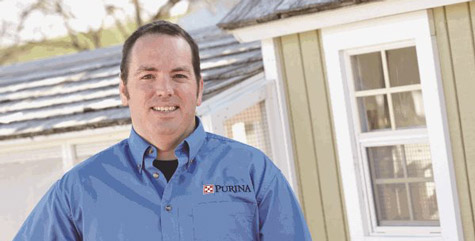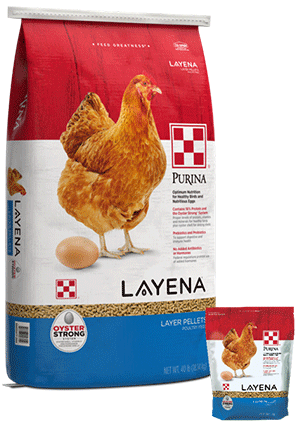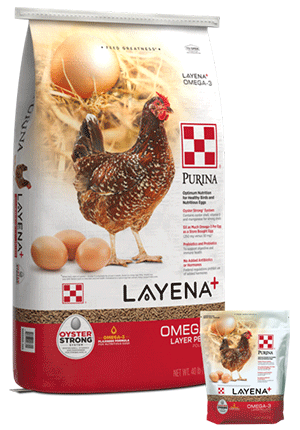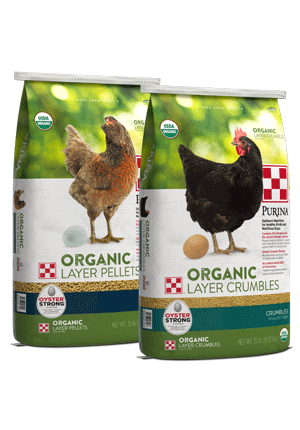
When Do Chickens Start Laying Eggs?
Flock Management : Layer Nutrition
Flock Management : Egg Production
Many hens lay their first egg around 18 weeks of age and then lay up to an egg each day, subject to breed, environment and individual bird. At 18 weeks, choose a complete layer feed with the Purina® Oyster Strong® System to help your hens lay strong and stay strong.
If raising a backyard flock was a treasure hunt, the ultimate prize would be a hen’s first egg. You started your chicks strong, moved them to the chicken coop and enjoyed their antics as they explored the backyard.
Now you might be feeling a bit of egg-ticipation and wondering when do chickens lay eggs? The first egg often arrives when hens are 18 weeks old, subject to breed, environment and nutrition. A rooster is not necessary for egg production unless you want to have fertilized eggs for hatching.
When pullets are nearing their first egg lay, their behavior changes. They may spend more time with the rooster, crouch for breeding or investigate the nesting area. At this time, keep them in the coop for short periods of time. Place golf balls or decoy eggs in the nesting boxes to help them understand the use of the nesting boxes.
The first few eggs a hen lays may be irregular – possibly small in size, with soft shells, no yolks or double yolks – but, after a week or so, egg production should become more consistent, with peak performance at about 30 weeks of age and egg goals changing each year.
To help hens lay strong and stay strong, provide them with these necessities:
Prepare chicken nesting boxes in the chicken coop.
Create several comfortable, clean and cozy chicken nesting boxes. On our farm, we built the nesting boxes into the coops with outdoor access for egg collection. We keep the boxes closed until the hens are 16 weeks old and then provide open-access after that.
A general rule for nesting box size is one 1-foot square nesting box for every four laying hens. The flock will take turns using the boxes. Line each nest box with a thick layer of straw, pine shavings or other bedding to cushion the eggs. Keep the nesting boxes up off the floor in the darkest corner of the coop to give your ladies privacy.
Each nest area should have a uniform environment. After a hen lays her first egg, it’s her tendency to lay in the same spot moving forward. If the hens decide one nest is preferable to the others, they may all try to use that nesting box, causing themselves stress, which can lead to egg breakage or egg eating.
Sometimes all your hens will use the same nesting box. As long as the birds aren’t fighting or harming each other, this is not a big issue. If you are concerned, consider blocking access to the preferred nest box and guiding the hens to other available boxes. Once the hens have decided the other nest boxes work just as well, allow them access to the original nest box.
Consider chicken coop light.
Age is the first indicator of first egg lay, but daylight hours are also critical. An increase in day length is a key driver to encouraging hens to lay eggs. To do their best work, laying hens prefer at least 16 hours of light and 8 hours of dark.
If your hen reaches 18 weeks of age during the fall or winter when daylight hours are shorter, then consider adding supplemental light to the coop. It only takes about 25-watts of incandescent light per 100 square feet to encourage hens to lay eggs. You can also use an equivalent wattage fluorescent or LED light for your flock. Without supplemental light, young hens may wait until days get longer in the spring to lay their first egg.
Switch to a complete chicken layer feed.
 The most important change to make when chickens lay their first egg is chicken feed. From day 1 through week 17, feed chicks and pullets a complete starter-grower feed with higher protein and lower calcium.
The most important change to make when chickens lay their first egg is chicken feed. From day 1 through week 17, feed chicks and pullets a complete starter-grower feed with higher protein and lower calcium.
Week 18 is the time to transition laying hens to a layer feed with the Purina® Oyster Strong® System to help them lay strong and stay strong. Which layer feed Oyster Strong® System is right for your flock?
- Purina® Layena® pellets or crumbles Our most popular layer feeds
- Purina® Layena® Omega-3 Includes added omega-3 fatty acids for your health
- Purina® Layena® High Protein Includes 19% protein and black fly soldier fly larvae
- Purina® Organic Layer Feed Certified USDA Organic
If hens are not laying at week 18, you can still transition from a chick starter feed to a layer feed. This change may even jumpstart egg production. The earliest you should transition to a layer feed would be around 16 weeks of age. Do this if you are combining a flock of new hens with an older flock in the same coop.
Chicken layer feed should include 16 percent protein and 3.25 – 4.5 percent calcium. Calcium is a key nutrient when it comes to the egg-laying process. Hens that lack proper calcium levels typically produce soft or brittle eggshells. Sometimes an improper calcium balance can cause hens to pull calcium from their bones to produce eggshells, weakening their overall skeletal structure.
Eggshells take roughly 20 hours to form, so hens need a steady supply of calcium in their layer feed. The Oyster Strong® System utilizes larger particles of oyster shell to provide a slow and steady release of calcium during the night when hens are forming eggshells. Vitamin D is like the taxi that gets the calcium into your hen’s bloodstream where it’s needed, while manganese helps strengthen and create the structure of the egg. The Oyster Strong® System brings all three nutrients together to help your hens make strong, healthy eggshells.
Choose one complete layer feed starting at the first egg and feed for at least 90 of the hen’s diet. Limit treats to less than 10 percent of their overall diet or provide a healthy treat, such as Purina® Farm to Flock® Larvae for Ladies™ hen treats or Purina® Farm to Flock® Protein Blend for Hens treats.
Level up with Oyster Strong® and sign-up today for the Feed Greatness® Challenge.




